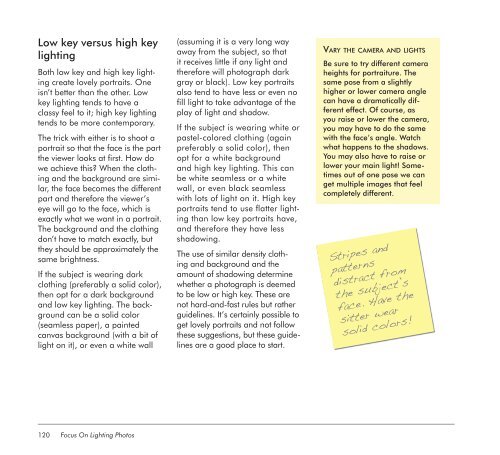Focus On Lighting Photos Focus on the Fundamentals.pdf
Create successful ePaper yourself
Turn your PDF publications into a flip-book with our unique Google optimized e-Paper software.
Low key versus high key<br />
lighting<br />
Both low key and high key lighting<br />
create lovely portraits. <str<strong>on</strong>g>On</str<strong>on</strong>g>e<br />
isn’t better than <strong>the</strong> o<strong>the</strong>r. Low<br />
key lighting tends to have a<br />
classy feel to it; high key lighting<br />
tends to be more c<strong>on</strong>temporary.<br />
The trick with ei<strong>the</strong>r is to shoot a<br />
portrait so that <strong>the</strong> face is <strong>the</strong> part<br />
<strong>the</strong> viewer looks at first. How do<br />
we achieve this? When <strong>the</strong> clothing<br />
and <strong>the</strong> background are similar,<br />
<strong>the</strong> face becomes <strong>the</strong> different<br />
part and <strong>the</strong>refore <strong>the</strong> viewer’s<br />
eye will go to <strong>the</strong> face, which is<br />
exactly what we want in a portrait.<br />
The background and <strong>the</strong> clothing<br />
d<strong>on</strong>’t have to match exactly, but<br />
<strong>the</strong>y should be approximately <strong>the</strong><br />
same brightness.<br />
If <strong>the</strong> subject is wearing dark<br />
clothing (preferably a solid color),<br />
<strong>the</strong>n opt for a dark background<br />
and low key lighting. The background<br />
can be a solid color<br />
(seamless paper), a painted<br />
canvas background (with a bit of<br />
light <strong>on</strong> it), or even a white wall<br />
120<br />
<str<strong>on</strong>g>Focus</str<strong>on</strong>g> <str<strong>on</strong>g>On</str<strong>on</strong>g> <str<strong>on</strong>g>Lighting</str<strong>on</strong>g> <str<strong>on</strong>g>Photos</str<strong>on</strong>g><br />
(assuming it is a very l<strong>on</strong>g way<br />
away from <strong>the</strong> subject, so that<br />
it receives little if any light and<br />
<strong>the</strong>refore will photograph dark<br />
gray or black). Low key portraits<br />
also tend to have less or even no<br />
fill light to take advantage of <strong>the</strong><br />
play of light and shadow.<br />
If <strong>the</strong> subject is wearing white or<br />
pastel-colored clothing (again<br />
preferably a solid color), <strong>the</strong>n<br />
opt for a white background<br />
and high key lighting. This can<br />
be white seamless or a white<br />
wall, or even black seamless<br />
with lots of light <strong>on</strong> it. High key<br />
portraits tend to use flatter lighting<br />
than low key portraits have,<br />
and <strong>the</strong>refore <strong>the</strong>y have less<br />
shadowing.<br />
The use of similar density clothing<br />
and background and <strong>the</strong><br />
amount of shadowing determine<br />
whe<strong>the</strong>r a photograph is deemed<br />
to be low or high key. These are<br />
not hard-and-fast rules but ra<strong>the</strong>r<br />
guidelines. It’s certainly possible to<br />
get lovely portraits and not follow<br />
<strong>the</strong>se suggesti<strong>on</strong>s, but <strong>the</strong>se guidelines<br />
are a good place to start.<br />
vary <strong>the</strong> camera and Lights<br />
Be sure to try different camera<br />
heights for portraiture. The<br />
same pose from a slightly<br />
higher or lower camera angle<br />
can have a dramatically different<br />
effect. Of course, as<br />
you raise or lower <strong>the</strong> camera,<br />
you may have to do <strong>the</strong> same<br />
with <strong>the</strong> face’s angle. Watch<br />
what happens to <strong>the</strong> shadows.<br />
You may also have to raise or<br />
lower your main light! Sometimes<br />
out of <strong>on</strong>e pose we can<br />
get multiple images that feel<br />
completely different.<br />
Stripes and<br />
patterns<br />
distract from<br />
<strong>the</strong> subject’s<br />
face. Have <strong>the</strong><br />
sitter wear<br />
solid colors!



